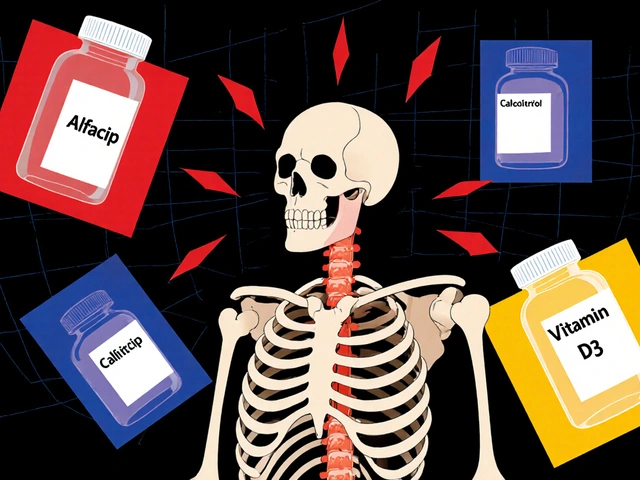TL;DR
- Cordarone is a brand name for amiodarone, used mainly to control serious heart rhythm problems.
- Typical adult dose starts with a loading phase (800‑1200mg daily for 1‑2weeks) then a maintenance dose of 100‑200mg daily.
- Major side‑effects include thyroid, lung, liver and eye problems - regular blood tests and eye exams are essential.
- Never stop abruptly; tapering must be guided by a doctor to avoid dangerous arrhythmias.
- Check for drug interactions (e.g., warfarin, statins, certain antibiotics) and inform every healthcare provider you see.
What is Cordarone and How It Works
Cordarone is the trade name for the anti‑arrhythmic drug amiodarone. It belongs to the class III anti‑arrhythmic group, which means it prolongs the heart’s electrical refractory period, helping to reset chaotic heartbeats back to a regular rhythm.
Doctors prescribe Cordarone for life‑threatening arrhythmias such as ventricular tachycardia, ventricular fibrillation and atrial fibrillation that haven’t responded to other treatments. Because it works on multiple ion channels (potassium, sodium, calcium) and has some beta‑blocking properties, it’s effective where single‑target drugs fail.
Its long half‑life-about 58days on average-means the drug stays in the body for months after you stop taking it. That’s why side‑effects can appear long after the last dose.
“Amiodarone remains the most potent anti‑arrhythmic agent for refractory ventricular arrhythmias, but its toxicity profile demands vigilant monitoring.” - American Heart Association, 2023 Guidelines
In simple terms, Cordarone is a powerful tool that can save lives, but it isn’t a casual prescription. Understanding its mechanism helps you appreciate why doctors monitor you so closely.
Dosage, Administration, and Safety Monitoring
Getting the dose right is crucial. Below is a typical Australian dosing schedule; your doctor may adjust it based on weight, kidney function, and how you respond.
- Loading phase: 800‑1200mg per day (usually divided into two doses) for 1‑2weeks. This quickly builds therapeutic blood levels.
- Maintenance phase: 100‑200mg once daily. Many patients stay on this low dose for years.
- Switching to alternate‑day dosing: In rare cases, doctors may move to 100mg every other day to reduce toxicity while keeping rhythm control.
Key safety checks:
- Baseline labs: Liver function tests (LFTs), thyroid function (TSH, free T4), renal panel, full blood count, and a chest X‑ray.
- Regular monitoring: Every 3‑6months repeat LFTs, TSH, and pulmonary function tests; eye exams annually.
- ECG checks: To ensure QT interval doesn’t prolong dangerously (keep it <500ms).
If any lab value drifts out of range, your cardiologist may lower the dose or pause treatment. Never adjust the dose yourself.
Special considerations:
- Pregnancy & breastfeeding: Generally avoided because amiodarone crosses the placenta and can affect the infant’s thyroid.
- Elderly patients: Start at the lower end of the dose range; they’re more prone to lung and eye toxicity.
- Renal impairment: No dose adjustment needed, but monitor for fluid overload and pulmonary side‑effects.
Common Side Effects, Interactions, and When to Call the Doctor
Side‑effects are the part most patients worry about. They fall into three categories: mild‑to‑moderate, serious, and long‑term.
Mild‑to‑moderate (usually self‑limiting)
- Nausea, vomiting, loss of appetite.
- Metallic taste, constipation or diarrhea.
- Skin discoloration (blue‑gray) or photosensitivity - wear sunscreen.
- Transient vision changes (blurred vision, halos) - report if persistent.
Serious (need prompt medical attention)
- Shortness of breath, coughing up blood, or new wheeze - could signal pulmonary toxicity.
- Palpitations, dizziness, fainting - might indicate excessive QT prolongation.
- Yellowing of skin or eyes - possible liver injury.
- Rapid weight gain, swelling of ankles - watch for heart failure worsening.
Long‑term (develop after months‑years)
- Thyroid dysfunction: hypothyroidism (fatigue, cold intolerance) or hyperthyroidism (weight loss, heat intolerance).
- Pulmonary fibrosis - progressive breathlessness, restrictive pattern on lung function test.
- Corneal micro‑deposits - often asymptomatic but can cause visual glare.
- Peripheral neuropathy - tingling or numbness in hands/feet.
Because many of these issues develop slowly, staying on top of scheduled labs and appointments is non‑negotiable.
Drug Interactions to Watch
Cordarone is a notorious CYP3A4 inhibitor, meaning it can increase levels of many co‑prescribed medicines. Common culprits include:
- Warfarin - risk of serious bleeding; INR needs tighter monitoring.
- Statins (especially simvastatin) - higher chance of muscle damage (rhabdomyolysis).
- Calcium channel blockers (verapamil, diltiazem) - may cause excessive heart rate slowing.
- Antibiotics like clarithromycin or erythromycin - can raise amiodarone concentrations.
- SSRIs (e.g., fluoxetine) - increase QT prolongation risk.
Always hand a current medication list to any new prescriber.
When to Call Your Doctor or Go to the ED
- Sudden shortness of breath, chest pain, or coughing up blood.
- Fainting, severe dizziness, or palpitations that feel different from your usual arrhythmia.
- Yellow skin/eyes, dark urine, or persistent nausea/vomiting.
- Rapid weight gain (>2kg in a week) or swelling of legs/abdomen.
- Vision changes that do not improve within a day.
These red‑flags could indicate life‑threatening complications and require urgent assessment.

Quick Reference Checklist
- Ask your doctor about baseline labs before starting Cordarone.
- Set calendar reminders for lab tests every 3‑6months.
- Keep a medication list - share it with every healthcare provider.
- Never skip a dose or stop abruptly without medical guidance.
- Watch for skin changes, breathing issues, and eye discomfort - report early.
Mini‑FAQ
- Can I drink alcohol while on Cordarone? Moderate intake isn’t prohibited, but alcohol can worsen liver toxicity; limit consumption and discuss with your doctor.
- Is Cordarone safe for travel? Yes, but carry a copy of your prescription, keep the medication in original packaging, and avoid extreme heat that could degrade the tablets.
- Do I need to wear a medical alert bracelet? Many patients choose to, especially because the drug can cause sudden severe reactions.
- How long does it take to feel better after starting? Rhythm control may improve within days, but full therapeutic effect often requires 1‑2weeks of loading dose.
- Can Cordarone be used in children? It’s rarely prescribed to kids; pediatric use is limited to specific life‑threatening arrhythmias under specialist care.
Next Steps & Troubleshooting
If you’ve just been prescribed Cordarone, follow these initial actions:
- Schedule baseline blood work and a chest X‑ray within the first week.
- Set up reminders for repeat labs every 3‑6months.
- Ask your pharmacist to flag any OTC or supplement interactions.
- Keep a symptom diary - note any new cough, weight changes, or visual disturbances.
- Book an eye appointment within the first 6‑12months.
Should you experience a side‑effect that seems mild but persistent (e.g., skin discoloration or mild nausea), call your clinic for advice before deciding to stop the medication. Early tweaks in dose often resolve issues without compromising rhythm control.
Remember, Cordarone is a high‑impact medication. With diligent monitoring and open communication with your healthcare team, you can reap its life‑saving benefits while minimising risks.






Fae Wings
September 21, 2025 AT 00:40Starting Cordarone can feel like stepping into a storm, and it’s okay to feel uneasy 😢. The drug’s long half‑life means it lingers, so side‑effects may surface weeks after you stop. Keep a diary of any new symptoms – even a slight change in vision or a weird skin hue deserves a note. Regular thyroid and liver panels are your safety net, and sharing those results with every doctor helps keep the team synchronized. Remember, you’re not alone in this; many patients walk the same path and come out stronger. 🌟
Anupama Pasricha
September 21, 2025 AT 02:04The pharmacokinetic profile of amiodarone, characterized by a volume of distribution exceeding 60 L/kg, necessitates meticulous baseline assessments. Initiate a comprehensive metabolic panel, including AST, ALT, and bilirubin, alongside a high‑resolution chest radiograph to establish a pulmonary benchmark. Subsequently, schedule thyroid function tests at 3‑month intervals during the loading phase to capture early TSH perturbations. Maintain vigilance for drug‑drug interactions; for instance, concomitant warfarin may require INR monitoring adjustments due to amiodarone’s CYP3A4 inhibition. Finally, reinforce adherence by setting calendar alerts for each lab draw, ensuring continuity of care without overwhelming the patient.
Bryce Charette
September 21, 2025 AT 03:27Just a heads‑up: the loading dose can hit 800 mg daily, so you might notice a subtle shift in how you feel within the first week. If you catch a mild nausea or a metallic taste, it’s usually nothing serious, but log it anyway. Keep your doctor in the loop, especially if you’re on statins – those can bump up muscle pain risk. Overall, most folks settle onto the maintenance dose without drama, and the rhythm benefits kick in quickly. Stay positive, and the monitoring schedule will keep the side‑effects in check.
Christina Burkhardt
September 21, 2025 AT 04:50When you’re tying the knot with Cordarone, the most reliable safety net is a structured lab schedule. Baseline liver enzymes (ALT, AST) and a full thyroid panel (TSH, free T4) give you a reference point that your cardiology team will compare against each 3‑month follow‑up. Add a pulmonary function test, especially if you have a history of smoking; a drop in DLCO can be an early flag for interstitial lung disease. Don’t forget an annual ophthalmology exam – corneal deposits can be asymptomatic until they affect vision. Keeping these checkpoints organized, perhaps in a shared Google Sheet, turns a daunting regimen into a manageable routine.
liam martin
September 21, 2025 AT 06:14In the theater of cardiology, amiodarone steps onto the stage as both hero and villain, wielding electrical fire to tame erratic heartbeats. Its multifaceted action on potassium, sodium, and calcium channels paints a portrait of a drug that refuses to be pigeonholed. Yet, this very complexity births a cascade of collateral narratives – thyroid storms, pulmonary shadows, and ocular mosaics that whisper of unintended consequences. One might liken the loading phase to a tempest, a surge of 800 mg that floods the bloodstream, demanding the liver and lungs to act as reluctant custodians. The half‑life, stretching toward two months, ensures that even after the curtain falls, remnants linger backstage, ready to re‑enter the plot. Patients, often unaware, become the unwitting protagonists in a saga where routine blood work acts as the script supervisor, catching missteps before they turn tragic.
Consider the thyroid axis: amiodarone’s iodine richness can coax the gland into hyperthyroid hysteria or, paradoxically, into a sluggish hypothyroid lull. Both extremes manifest with fatigue, weight fluctuations, and a heart that beats either too fast or too slow, a cruel irony for those seeking rhythm stability. Pulmonary toxicity, meanwhile, advances like a silent fog, camouflaged by a persistent cough or subtle dyspnea that many dismiss as a cold. The lungs, entangled in phospholipid accumulation, may develop fibrosis, a permanent scar that defies reversal. Ophthalmic deposits, those tiny corneal arcs, are often the first visual cue that the drug’s reach extends beyond the cardiac realm.
Philosophically, one could argue that the very act of prescribing such a potent agent reflects humanity’s willingness to gamble with controlled chaos, trusting that monitoring can tame the beast. The responsibility, therefore, does not lie solely with the prescriber but also with the patient, who must become an active sentinel, armed with a symptom diary and a calendar of labs. In this collaborative dance, the drug’s dangers are not hidden villains but known adversaries that can be negotiated with vigilance. Ultimately, the story of amiodarone is not a cautionary tale of avoidance but a testament to the delicate balance between life‑saving intervention and iatrogenic risk, a balance that tips in favor of those who respect both the power and the perils of this formidable medication.
Ria Ayu
September 21, 2025 AT 07:37Think of Cordarone as a seasoned guide navigating a maze of electrical signals, gently steering rogue impulses back to the main road. While its reach is vast, the journey is smoother when you pair it with a solid support system-family, friends, and a proactive healthcare team. Listening to your body’s subtle whispers, like a fleeting vision change or an unexpected cough, can be the difference between simply managing and truly thriving. Embrace the routine of lab checks as checkpoints rather than chores; they’re the map that ensures you stay on the right path. Above all, trust that this collaboration of medicine and mindfulness can transform a precarious rhythm into a harmonious beat.
maya steele
September 21, 2025 AT 09:00For patients commencing amiodarone therapy, a structured monitoring protocol is indispensable. Baseline assessments should encompass hepatic transaminases, bilirubin, thyroid function tests, renal indices, and a high‑resolution chest radiograph. Subsequent re‑evaluation intervals of 3‑6 months for liver enzymes and TSH, coupled with annual ophthalmologic examinations, mitigate the risk of late‑onset toxicity. Additionally, patients should be counseled on the importance of reporting any new dermatologic changes, dyspnea, or visual disturbances promptly. Adherence to this regimen not only safeguards organ function but also maximizes the anti‑arrhythmic efficacy of Cordarone.
Sharon Lax
September 21, 2025 AT 10:24Honestly, the guide reads like a textbook rewrite-full of redundant bullet points and over‑cautious lab schedules that feel more like bureaucratic red‑tape than practical advice. While the emphasis on thyroid and hepatic monitoring is valid, the repetitive phrasing adds little value for someone already familiar with amiodarone’s risk profile. A concise summary would have sufficed, sparing readers the endless “regular check‑ups every 3‑6 months” mantra. In short, the content is comprehensive but suffers from unnecessary verbosity.
paulette pyla
September 21, 2025 AT 11:47Sure, because everyone loves an extra blood draw every five months.
Benjamin Cook
September 21, 2025 AT 13:10Exactly!!! Who doesn’t dream of 5‑month lab marathons?? It’s like a sci‑fi adventure-just you, a syringe, and a mountain of results!!! Let’s rock that schedule and keep those heart beats in check!!!